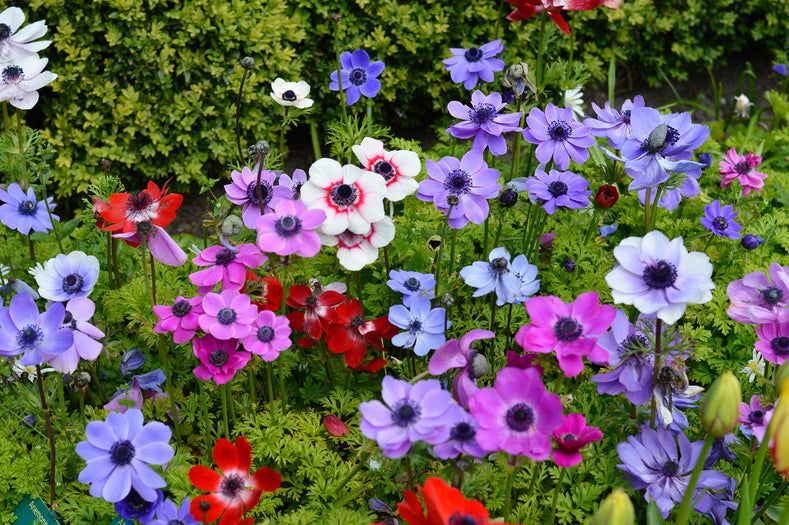Anemones – Easy growing eye catchers
Tulips, narcissi, hyacinths, snowdrops…. there are so many beautiful flower bulbs, and they all have their own charm and characteristics. In this blog series we would like to introduce you to a variety of them, helping you to make the best choices for your garden and grow the spring display of your dreams!
Perfect Stereotype
If you would ask a child to draw a flower, the end product would end up looking very much like Anemones, which bloom in an almost cartoon-like manner. But apart from being a happy stereotype, they’re also excellent naturalizers, their seeds blowing around on the breeze and settling anywhere they can. This makes these Daisy-like flower bulbs great ‘fillers’ of spaces where you hadn’t planted anything just yet, and if you stick with just one color, Anemones can have a very ‘unifying’ effect in your garden. Once they’re blooming you can create bouquets to your heart’s content, as Anemones are fantastic as cut flowers. Pro tip: After you’ve picked them, sear the end of the stem in boiling water for 15 seconds, and they’ll last much longer.

Plant Passport
- Height
Anemones Blanda grow up to 6 inches in height, while the St. Brigid & de Caen flowers on a stem that’s about 8 inches high.
- Fragrance
Anemones are very pretty, but they’re not fragrant.
- Color
Blanda Anemones come in tender white and purplish blue, whereas the de Caen and St. Brigid varieties come in classic Anemone colors like white, purplish blue and red. However, for de Caen DutchGrown also carries a few more exclusive varieties, such as the Bi-Color which is white with red accents, and Sylphide, which is a bright scarlet pink.
- Bloom time
The Blanda varieties bloom in early to mid spring, after which the St. Brigid & de Caen varieties take over, blooming from mid to late spring.
- Longevity
Anemones come back every year, making them perennial flower bulbs. And since you’ll get a lot more every year, they’re great naturalizers too.
- Different types
Anemones come in a few varieties, one of them being Blanda Anemones. They are also known as Windflowers, and are the ones that look most like daisies. Another variety in our collection is Coronaria, which can subdivided into the St. Brigid variety, with its semi-double petals, and the de Caen variety with its poppy-like large petals.
- Planting
Anemones like to be warm, and the de Caen variety will do really well in hot climes, doing best in USDA zones 7-10. Blanda Anemones prefer a bit more temperate regions, being well suited to USDA zones 5-8. Since Anemones grow low, they are perfect for border beds and rock gardens, where mass-planting them will deliver a riot of color. When you first see your Anemone bulbs, called corms, they will look very wrinkly and dry. To rehydrate them, soak them in lukewarm water for a few hours before planting. Find a spot that gets full sun or partial shade, with good drainage. Plant de Caen and st Bridgid 3 inches deep, and Blanda 2 inches deep. Since Anemones are deer resistant all you have to do after planting is water them well and then leave them to their devices, as time & temperature will do the rest.
- Forcing
Since Anemones don’t need pre-chilling to flower, they are great for indoor forcing. The first thing you do is soak the bulbs in lukewarm water for 2-4 hours to rehydrate them. Fill a well-draining pot with soil (ideally loam with some grit), and plant the bulbs about 1 inch deep, leaving the tops of the tips exposed. Water well, and do regularly check that the soil is still hydrated (but not soggy) in the 10-12 weeks it takes from planting to blooming.
- Container Planting
Plant pre-soaked Anemone bulbs in well-draining containers, at a depth of about 1.5 inches, close together but not touching. A mix of different colored Anemones will look wonderful in a wicker basket or other woven container, and very stylish in metal pots and planters.
- Pricing
DutchGrown’s top-size high-quality Anemones are very affordable, with the Blanda Mix starting at $0.28/ bulb for 25 bulbs, but going down more than 50% to $0.12/ bulb for 5000 bulbs. 25 bulbs of St. Brigid and de Caen cost $0.42/ bulb, but are reduced 48% when you buy 5000 bulbs, costing only $0.22/ bulb. Our Elite de Caens are $0.48/ bulb for 25 and $0.32/ bulb for 5000 bulbs.
- Combinations
Blanda Anemones, blooming in early to mid spring, will go great with Grape Hyacinths, while st Brigid & de Caen look splendid mixed in with mid to late spring yellow tulips like Big Smile, or the light yellow miniature tulip Battalini Bright Gem.
Hot Spring
If you live in a warmer area, Anemones are the flower bulbs for you: abundant amounts of color can grace your garden as early as next Spring. Pop on over to our website and create the perfect Anemone mixture for your taste and budget, and we’ll send them to you as soon as they’re ready to be planted.
